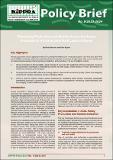| dc.description.abstract | Honey production in Kenya holds a great promise of
improving the livelihood of honey producers. It has a
huge potential specifically in the arid and semi-arid lands
of Kenya, characterized by dry weather conducive for
apiculture. Arid and semi-arid areas of Kenya also have
rich flora and fauna such as Acacia trees, which provide
quality nectar for honey production. Despite holding this
potential, honey production in Kenya has consistently
fallen significantly short of its estimated potential of
100,000 metric tonnes annually. For instance, in 2021,
Kenya’s annual honey production reached a modest
17,265 tonnes with a five-year average of 18,521 tonnes
between 2017 and 2021 as reported by FAOSTAT.
Similarly, the marketed output of honey falls short of the
market demand, leading to the importation of natural
honey. Over the years, Kenya has been a net importer
of natural honey. The numbers reveal a trade deficit
between 2013 and 2021, with imports amounting to
US$ 3,307,572 and exports totalling US$ 2,542,457 as
indicated by UN-COMTRADE. This trade imbalance
underscores a fundamental issue that Kenya’s
quantities of marketed honey production fall short of
market demand from households and industries such as
beauty, food, and pharmaceuticals. The failure to meet
market demand can be linked to low uptake of honey
commercialization in Kenya. Honey commercialization
is key to improving the livelihood of communities in
the ASALs through the generation of employment
opportunities, diversified income sources, and value
addition. The regional development authorities such
as Kerio Valley Development Authority and Tana River
Development Authority have programmes that aim
to increase honey commercialization through farmer
capacity building, encouraging adoption of modern bee
hives and provision of ready markets to the farmers. | en |

